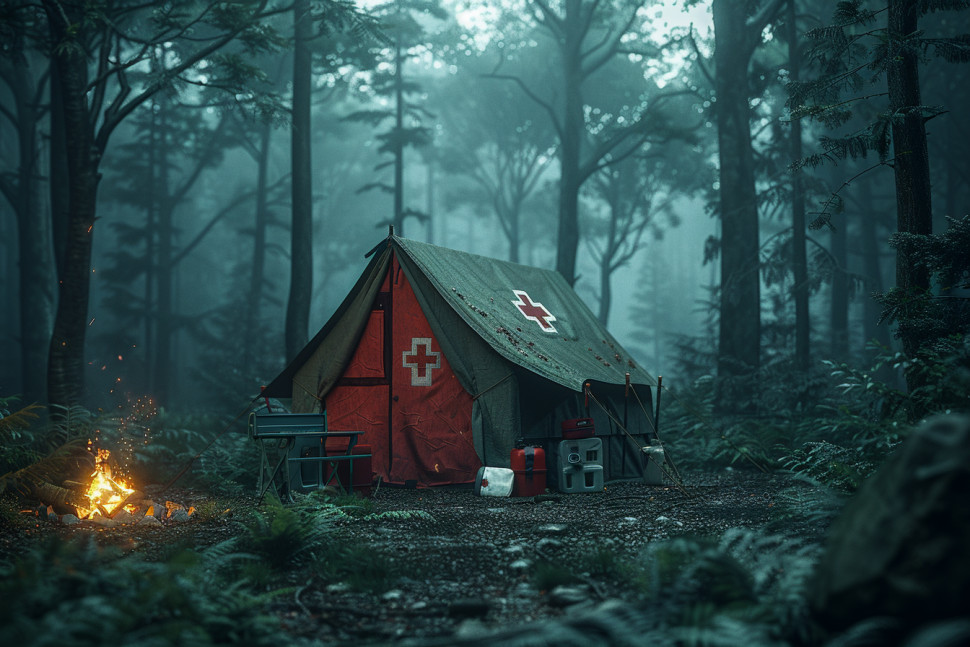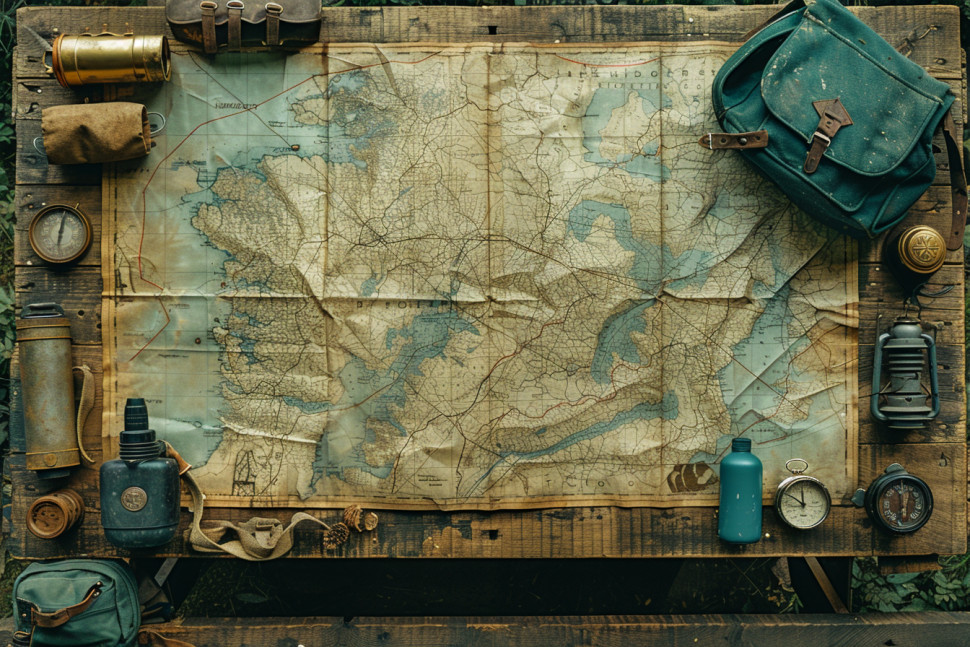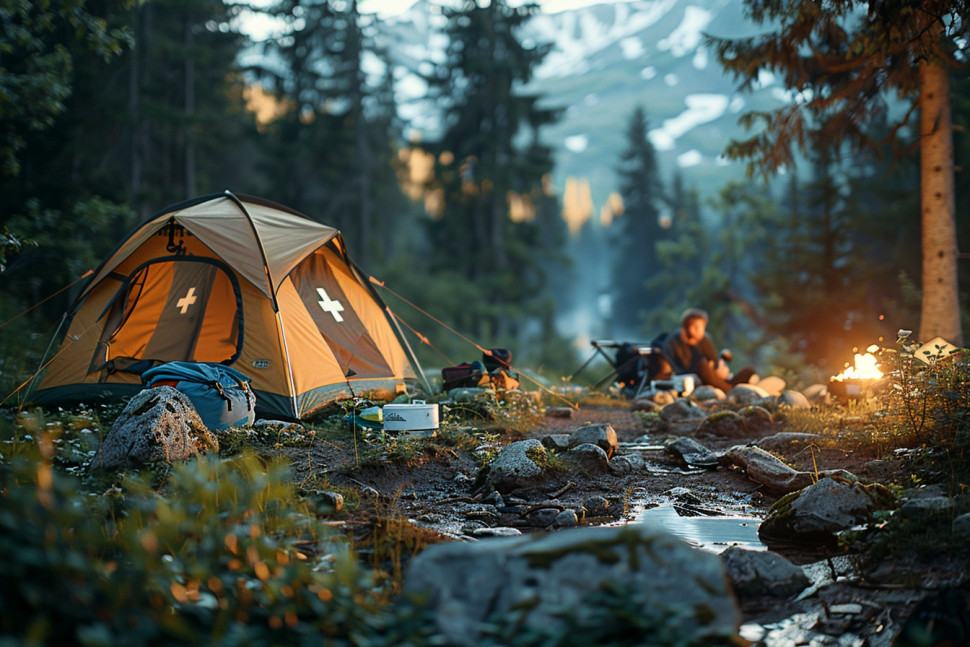Survival Techniques for Wilderness Camping

Key Takeaways
- Planning and preparation are essential for a safe wilderness camping experience
- Learn essential survival skills like shelter-building into the wilderness
- Pack appropriate gear and supplies and plenty of food and water
- Know how to purify water from natural sources in case of emergency
- Practice Leave No Trace principles to minimize your impact on the environment
- Stay calm under pressure to increase your chances of survival
- Consider taking a wilderness survival course or guided trip to build your skills
- Always let someone know your planned route and expected return date
- Remember that wilderness camping is an opportunity to challenge yourself and find inner
Introduction: Embracing the Call of the Wild
Picture this: you're miles from civilization, surrounded by towering trees, rugged mountains, and pristine lakes. The only sounds are the rustling of leaves, the chirping of birds, and the crackle of your campfire. This is wilderness camping, an opportunity to escape the stresses of modern life and immerse yourself in the raw beauty of the natural world.
But with great adventure comes great responsibility. When you venture into the backcountry, you leave behind the safety net of society and must rely on your own skills and resources to survive. That's where survival techniques come in - a set of knowledge and practices that can help you stay safe, comfortable, and self-sufficient in the wilderness.
In this article, we'll explore some of the most essential survival techniques for wilderness camping, from planning and preparation to fire-making, shelter-building, navigation, and more. Whether you're a seasoned outdoorsperson or a curious beginner, these tips and tricks will help you embrace the call of the wild with confidence and competence. So grab your backpack, lace up your boots, and let's dive in!

Planning and Preparation: The Foundation of Survival
The most important survival technique for wilderness camping happens before you even set foot on the trail: proper planning and preparation. By taking the time to research your destination, gather the right gear and supplies, and develop a solid plan, you'll be setting yourself up for success and minimizing the risk of emergencies.
Some key steps in the planning process include:
- Researching the area you'll be visiting, including the terrain, climate, weather patterns, and any potential hazards like wildlife or water crossings
- Checking local regulations and obtaining any necessary permits or reservations
- Creating a detailed trip plan and sharing it with a trusted friend or family member, including your route, expected return date, and emergency contact information
- Gathering appropriate gear and supplies, including a reliable tent, sleeping bag, cooking equipment, water filtration system, first aid kit, and plenty of food and water
- Developing a menu plan and packing lightweight, non-perishable, and high-energy foods like trail mix, energy bars, and dehydrated meals
- Studying maps and learning basic navigation skills like using a compass and reading terrain features
- Packing appropriate clothing layers for the expected weather conditions, as well as rain gear and extra insulation
- Carrying a means of communication like a satellite phone or personal locator beacon in case of emergency
By taking the time to plan and prepare thoroughly, you'll be able to focus on enjoying your wilderness experience rather than worrying about what could go wrong. And if an emergency does arise, you'll have the tools and knowledge you need to handle it with confidence.

Fire-Making: The Key to Warmth, Light, and Cooking
One of the most important survival skills for wilderness camping is the ability to make fire. Fire provides warmth, light, and a means of cooking food and purifying water. It can also serve as a signal for rescue and a psychological boost in challenging situations.
There are many ways to start a fire in the wilderness, from traditional methods like friction fire-making to modern tools like matches, lighters, and ferrocerium rods. Regardless of your preferred method, it's essential to practice your fire-making skills before you need them in a survival situation.
Some tips for successful fire-making include:
- Gathering a variety of tinder, kindling, and fuel wood in different sizes, from fine, dry materials like grass and leaves to larger sticks and logs
- Building your fire in a safe location, away from overhanging branches and clear of flammable debris
- Using a fire starter like cotton balls soaked in petroleum jelly or commercial fire starters to get your tinder burning quickly
- Arranging your tinder, kindling, and fuel in a structure that allows for good airflow, like a teepee or pyramid shape
- Blowing gently on your tinder to provide oxygen and help the flames grow
- Gradually adding larger sticks and logs as the fire becomes established, and maintaining it by adding more fuel as needed
In addition to traditional campfires, it's also a good idea to carry a lightweight backpacking stove and fuel as a backup cooking method. Stoves are more efficient and leave less impact than fires, and can be a lifesaver in wet or windy conditions.

Shelter-Building: Staying Dry and Protected
Another critical survival skill for wilderness camping is the ability to build a shelter. A well-constructed shelter can protect you from the elements, provide a sense of security and comfort, and even help regulate your body temperature in extreme conditions.
There are many types of wilderness shelters, from simple lean-tos and debris huts to more complex structures like quinzhees and snow caves. The type of shelter you build will depend on the environment, the materials available, and your level of skill and experience.
Some general tips for shelter-building include:
- Choosing a location that is safe, dry, and level, away from hazards like falling trees, flash floods, and animal dens
- Using natural materials like branches, leaves, and grasses to create a framework and insulation
- Orienting your shelter to provide maximum protection from the wind and rain
- Creating a waterproof roof using materials like tarps, ponchos, or bark
- Building a raised bed using leaves, pine needles, or other soft materials to insulate you from the cold ground
- Ensuring adequate ventilation to prevent condensation and allow for air circulation
- Practicing your shelter-building skills in a variety of environments and conditions before you need them in a survival situation
In addition to natural shelters, it's also a good idea to carry a lightweight tent or bivy sack as a backup option. Modern tents are designed to be quick and easy to set up, and can provide reliable protection from the elements.

Navigation: Finding Your Way in the Wild
Getting lost is one of the most common fears among wilderness campers, and for good reason. When you're miles from civilization with no clear trails or landmarks, it can be easy to become disoriented and lose your way.
That's why navigation is such an essential survival skill for wilderness camping. By learning how to read maps, use a compass, and identify natural landmarks, you can stay on course and find your way back to safety even in challenging conditions.
Some key navigation techniques include:
- Studying maps and familiarizing yourself with the terrain, water sources, and other features of your destination before you leave home
- Carrying a detailed topographic map and compass, and knowing how to use them to determine your location and direction of travel
- Paying attention to natural landmarks like mountains, rivers, and distinctive rock formations, and using them to orient yourself and track your progress
- Using the sun and stars to determine direction, by knowing that the sun rises in the east and sets in the west, and that the North Star remains fixed in the northern sky
- Leaving clear markers like cairns or blazes to help you retrace your steps if needed
- Staying calm and logical if you do become lost, and using techniques like STOP (Sit, Think, Observe, Plan) to assess your situation and make a plan
In addition to traditional navigation tools, many wilderness campers also carry GPS devices or satellite communicators as a backup. While these tools can be incredibly useful, it's important to remember that they are not foolproof and can fail or lose signal in remote areas. It's always a good idea to have a solid foundation in traditional navigation skills as well.

Water and Food: Staying Hydrated and Nourished
Water and food are two of the most basic human needs, and they become even more critical in a wilderness survival situation. When you're miles from the nearest water source or grocery store, it's essential to know how to find, purify, and store safe drinking water, as well as how to identify and prepare edible plants and animals.
Some key techniques for staying hydrated and nourished in the wilderness include:
- Carrying plenty of water and a reliable means of purification, like a water filter, chemical treatment, or boiling
- Knowing how to identify and collect water from natural sources like streams, springs, and dew
- Packing lightweight, non-perishable, and high-energy foods like trail mix, energy bars, and dehydrated meals
- Learning to identify and prepare edible plants like berries, nuts, and greens, and knowing which plants to avoid
- Knowing basic hunting and fishing techniques, and carrying appropriate gear like a fishing kit or snare wire
- Practicing proper food storage techniques to prevent spoilage and attract wildlife, like hanging food bags or using bear canisters
It's also important to pay attention to your body's signals and to stay hydrated and nourished even when you don't feel thirsty or hungry. Dehydration and malnutrition can sneak up on you in the wilderness, and can quickly lead to fatigue, confusion, and other dangerous symptoms.

First Aid: Treating Injuries and Illnesses in the Field
Accidents and illnesses can happen anywhere, but they can be especially challenging to deal with in the wilderness, where medical help may be hours or days away. That's why it's essential for wilderness campers to have a solid foundation in first aid skills and to carry a well-stocked first aid kit.
Some common wilderness first aid scenarios include:
- Cuts, scrapes, and blisters from hiking and camping activities
- Sprains, strains, and fractures from falls or accidents
- Hypothermia and frostbite from exposure to cold temperatures
- Heat exhaustion and heat stroke from exposure to hot temperatures
- Insect bites, stings, and allergic reactions
- Gastrointestinal illnesses from contaminated water or food
- Altitude sickness from rapid ascents to high elevations
To prepare for these and other medical emergencies, wilderness campers should:
- Take a wilderness first aid course and practice their skills regularly
- Carry a well-stocked first aid kit with items like bandages, antiseptic, pain relievers, and emergency blankets
- Know how to assess and treat common injuries and illnesses using basic first aid techniques like cleaning wounds, applying splints, and administering CPR
- Have a plan for evacuating or signaling for help in case of a serious emergency
- Know their own medical history and carry any necessary medications or supplies
By being prepared and knowledgeable about wilderness first aid, you can help prevent small injuries from becoming big problems, and can potentially save a life in a crisis situation.

Wildlife Safety: Coexisting with Nature's Inhabitants
One of the joys of wilderness camping is the opportunity to observe and appreciate wildlife in their natural habitats. However, encounters with animals can also pose risks to both humans and animals if not handled properly.
Some key tips for staying safe around wildlife include:
- Researching the types of animals you may encounter in your destination, and learning about their behavior, habitat, and potential threats
- Storing food and scented items securely in bear canisters or hung from trees to avoid attracting animals to your campsite
- Keeping a clean camp and disposing of waste properly to avoid habituating animals to human food sources
- Observing animals from a safe distance and never approaching, feeding, or harassing them
- Making noise while hiking to avoid surprising animals, and being especially cautious in areas with dense vegetation or near water sources
- Knowing how to respond to aggressive or defensive behavior from animals like bears, mountain lions, or moose
- Carrying bear spray or other deterrents in areas with high bear activity, and knowing how to use them properly
By respecting wildlife and taking appropriate precautions, wilderness campers can minimize the risk of negative encounters and help preserve the delicate balance of nature.

Mental Preparation: Cultivating a Survival Mindset
While physical skills and tools are essential for wilderness survival, perhaps the most important factor is mental preparation. When faced with a crisis situation in the backcountry, it's easy to panic, lose hope, or make poor decisions that can compound the problem.
That's why cultivating a positive, proactive, and resilient mindset is so critical for wilderness campers. Some key mental strategies include:
- Staying calm and focused in the face of adversity, and avoiding panic or despair
- Breaking challenges down into manageable steps and celebrating small victories
- Maintaining a positive attitude and a sense of humor, even in difficult circumstances
- Trusting in your skills, knowledge, and resourcefulness to find solutions and overcome obstacles
- Staying connected to your sense of purpose and the beauty of the natural world around you
- Practicing mindfulness and stress-reduction techniques like deep breathing, meditation, or journaling
- Seeking support and encouragement from fellow campers or loved ones back home
By developing mental toughness and emotional resilience, wilderness campers can not only survive, but thrive in the face of adversity. And by embracing the challenges and rewards of the wilderness experience, they can gain a deeper sense of self-reliance, confidence, and connection to the natural world.

Leave No Trace: Preserving the Wilderness for Future Generations
As wilderness campers, we have a responsibility to minimize our impact on the environment and to preserve the beauty and integrity of the natural world for future generations. The Leave No Trace principles provide a framework for responsible outdoor ethics and help ensure that our wilderness experiences are sustainable and respectful.
The seven Leave No Trace principles are:
- Plan ahead and prepare
- Travel and camp on durable surfaces
- Dispose of waste properly
- Leave what you find
- Minimize campfire impacts
- Respect wildlife
- Be considerate of other visitors
Some specific ways to practice Leave No Trace while wilderness camping include:
- Packing out all trash and waste, including food scraps and toilet paper
- Using existing campsites and trails whenever possible, and avoiding sensitive areas like meadows or wetlands
- Minimizing campfire impacts by using established fire rings, keeping fires small, and burning only dead and downed wood
- Leaving natural objects and cultural artifacts in place for others to enjoy
- Keeping a respectful distance from wildlife and avoiding disturbing their natural behaviors
- Being courteous to other campers and respecting their desire for solitude and quiet
By following these principles and setting a positive example for others, wilderness campers can help ensure that the wilderness remains a source of inspiration, adventure, and renewal for generations to come.
Natural Shelter Building: The Ultimate Guide To Wilderness Survival
Natural Shelter Building: The Ultimate Guide To Wilderness Survival provides essential knowledge on constructing shelters using materials found in nature, crucial for surviving in the wild. The guide covers various shelter designs, from simple lean-tos to more elaborate debris huts, offering step-by-step instructions for each. Understanding natural shelter building techniques is paramount for outdoor enthusiasts, hikers, and survivalists alike. With detailed illustrations and tips on selecting the ideal location, this guide equips readers with the skills needed to create effective wilderness shelters. Whether for a short camping trip or a survival situation, mastering these techniques is invaluable.
A Feast In The Heart Of Nature: Wild Edible Plants To Discover When Camping
When camping, exploring the wilderness can lead to exciting discoveries of wild edible plants that offer a feast for the senses. These plants, hidden in the heart of nature, provide a unique opportunity to connect with the environment and savor its bounty. From vibrant berries to fragrant herbs, foraging for these natural delicacies can enhance any outdoor adventure. Learning to identify and safely consume wild edibles adds a new dimension to the camping experience, allowing for a deeper appreciation of the land's offerings. Embrace the thrill of uncovering wild edible plants on your next camping trip and indulge in a feast that nature provides.
The Best Equipment For Wilderness Camping
When preparing for wilderness camping, it is crucial to have the best equipment that can withstand rugged conditions. A sturdy tent, sleeping bag, and portable stove are essential for a comfortable outdoor experience. Additionally, investing in a reliable water filtration system and durable hiking boots can make a significant difference in your camping trip. Choosing lightweight yet durable gear will help lighten your load while ensuring you have everything you need for a successful adventure. Proper equipment selection is key to enjoying a safe and memorable wilderness camping experience.
Finding Your Way Without a Compass: the Ultimate Guide to Never Getting Lost!
Navigating through unknown terrain without a compass can be a daunting task, but with the right knowledge and skills, it is possible to find your way successfully. Understanding natural signs like the sun's position and the growth patterns of plants can provide valuable guidance. Utilizing landmarks and mapping out mental routes can also aid in navigation without a compass. Learning basic orienteering techniques and honing your observation skills are essential for staying on course. Embracing the challenge of finding your way without traditional tools can lead to a deeper connection with the environment and a sense of accomplishment.
Conclusion: Embracing the Adventure of Wilderness Camping
Wilderness camping is not for the faint of heart. It requires physical stamina, mental toughness, and a willingness to embrace the unknown and the unpredictable. But for those who are drawn to the call of the wild, the rewards are immeasurable.
By learning and practicing essential survival techniques like fire-making, shelter-building, navigation, and first aid, wilderness campers can gain the skills and confidence they need to thrive in even the most challenging conditions. And by cultivating a positive mindset, respecting wildlife and the environment, and following Leave No Trace principles, they can ensure that their wilderness experiences are safe, sustainable, and deeply rewarding.
So if you're ready to step out of your comfort zone and into the wild, remember these key takeaways:
- Plan ahead and prepare thoroughly, both physically and mentally
- Learn and practice essential survival skills before you need them
- Stay calm, positive, and proactive in the face of challenges
- Respect wildlife and minimize your impact on the environment
- Embrace the adventure and the opportunity for personal growth and connection with nature
With these tools and mindsets, you'll be well.
